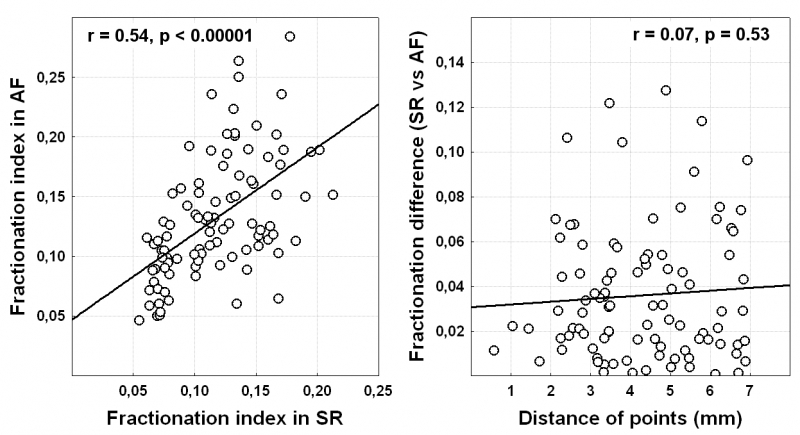THE RELATIONSHIP BETWEEN ATRIAL FIBRILLATION NESTS AND SITES WITH COMPLEX FRACTIONATED ATRIAL ELECTROGRAMS
Introduction: Targeting of complex fractionated atrial electrograms (CFAEs) assessed during atrial fibrillation (AF) and AF nests (AFNs) identified in sinus rhythm (SR) has been proposed for AF ablation. The direct association of both indices of AF substrate has not been investigated.
Methods: The study was performed in 10 patients with paroxysmal AF. We collected 94 pairs of left atrium (LA) endocardial electrograms obtained during SR and induced AF. The recording sites were evenly distributed in all LA areas outside of pulmonary veins. Voltages and degrees of fractionation were calculated for all electrograms and their correspondence in SR and AF was analyzed.
Results: Mean distance between pairs of points was 4.3 ± 1.6mm (range 0.6 - 7.0 mm). Degree of fractionation in AF was not correlated with the voltage of sinus electrograms (r = 0.16, p = 0.13). Fractionation indices in SR and AF were correlated moderately (r = 0.54, p<0.00001; Figure - left panel). Disagreement between fractionation in SR and AF was not significantly dependent on distance between pairs of points (r = 0.07, p = 0.53, Figure - right panel). When CFAEs and AFNs were defined by upper quartile of fractionation index, sensitivity of AFNs for the detection of CFAEs sites was only 42% with specificity of 80%.
Conclusions: Fractionation of sinus electrograms is significantly associated with a degree of fractionation in AF. Because this association is relatively weak, AF substrate ablation should preferably be guided by CFAEs mapping. The use of AFNs as a surrogate target for ablation might only be helpful if sustained AF is not inducible.


